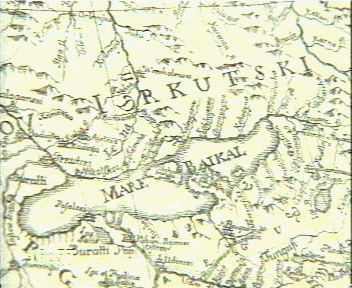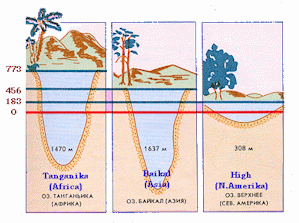Home![]() books
books
![]() ecology
ecology![]() Latest info
Latest info![]() from space
from space
![]() Encyclopedia
Encyclopedia![]() Animals
Animals![]() Plants
Plants![]() Climat
Climat![]() Research
Research![]() The world beneath Baikal
The world beneath Baikal![]() Geology
Geology![]() Circumbaikal railroad
Circumbaikal railroad![]() Photogallery # 1
Photogallery # 1![]() Photogallery # 2
Photogallery # 2![]() Photogallery # 3
Photogallery # 3![]() Listvyanka
Listvyanka![]() Natives
Natives![]() In German
In German![]() Word of poet
Word of poet![]() Olkhon island
Olkhon island![]() Earthwatch
Earthwatch
![]() Shopping
Shopping![]() Travel agences
Travel agences![]() Guestbook
Guestbook
![]()
Winter view of Baikal from space
Interesting factsLake Baikal's beauty is exceptional, and so is the beauty of the area surrounding it. Scientists are still debating the lake's origin. Some are trying to prove that it emerged as a result of tectonic processes of orogenesis, while others consider it as having been formed as a result of the earth's crust gradually subsiding. So far nobody has been proved right. |
It would take all the rivers of the world - Volga, Don, Dneper and Yenisei, Ural and Ob, Ganges and Orinoko, Amazon and Thames, Seine and Oder - nearly one year to fill lake Baikal's basin. It would take four hundred years for all the rivers, streams and brooks now flowing into the Siberian lake-sea to perform the task. |
| The Baikal area is a veritable treasure trove of mineral resources. Sables thrive in the region's taiga; valuable fur animals live in the surrounding mountains and valleys; and birds and fish abound in the forests and rivers of the area. The nearby Dauro-Mongolian steppes are very fertile. There are hot springs in the vicinity of Lake Baikal, the water of which is of excellent quality. The lake acts as a powerful generator and biofilter producing this water. |
Collecton of the articles in Russian
|
Click here for a detailed map of the south part of Baikal to download and print. (1.7 Mb ) |

|
|
|
Compared to the surrounding area, winter is milder and summer cooler on Lake Baikal. The average air temperature is about -19 C in January and February and about +11 C in August. The surface-water temperature on the open part of the lake in August is +9 to 12 C, and near the shore it is sometimes as high as +20 C.
 An ancient map
of Baikal.
An ancient map
of Baikal.

Lake Baikal usually freezes in January and the ice breaks in May. The ice is 70-115 cm. thick. The average annual precipitation in the middle and the north of Baikal is 200-350 mm.; it is 500-900 mm. in the south.
![]() Baikal
Currents-From local media and official sources
Baikal
Currents-From local media and official sources
![]() The
Baikal Center for Ecological and Citizen Initiatives
The
Baikal Center for Ecological and Citizen Initiatives
![]() Specialty
Travel Index: Baikal Lake
Specialty
Travel Index: Baikal Lake
![]() Baikal
Currents - Regional NGO's Projects
Baikal
Currents - Regional NGO's Projects
![]() Baikal
lazurite
Baikal
lazurite
![]() Comet
Hyakutake
Comet
Hyakutake
![]() About
Baikal in French
About
Baikal in French
Related URL links are welcome!
Home![]() Books
Books ![]() Ecology
Ecology![]() Latest
info
Latest
info
![]() from
space
from
space ![]() Encyclopedia
Encyclopedia
![]() Animals
Animals![]() Plants
Plants![]() Climat
Climat![]() Research
Research![]() The world beneath Baikal
The world beneath Baikal![]() Geology
Geology![]() Circumbaikal railroad
Circumbaikal railroad![]() Photogallery # 1
Photogallery # 1![]() Photogallery # 2
Photogallery # 2![]() Photogallery # 3
Photogallery # 3![]() Listvyanka
Listvyanka![]() Natives
Natives![]() In German
In German![]() Word of poet
Word of poet![]() Olkhon island
Olkhon island
![]() Earthwatch
Earthwatch
![]() Shopping
Shopping![]() Travel agences
Travel agences![]() Guestbook
Guestbook
realvideo
![]() Transsiberian
railway.
Transsiberian
railway.![]() Inside
the train at Transsiberian railway,download .mov 468kb
Inside
the train at Transsiberian railway,download .mov 468kb![]() Circumbaikal
railway
Circumbaikal
railway![]() Lake
Baikal beauty
Lake
Baikal beauty![]() Yachts
at Baikal
Yachts
at Baikal![]() Brown
bears at lake Baikal shores in spring
Brown
bears at lake Baikal shores in spring![]() Aqualangist
under Baikal ice
Aqualangist
under Baikal ice![]() At
lake Baikal beneath
At
lake Baikal beneath![]() Baikal
nerpas
Baikal
nerpas![]() History
of Trans-Siberian
railway
History
of Trans-Siberian
railway
![]()
|
|
|